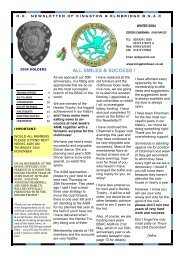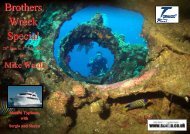At long last!
Download - Kingston & Elmbridge Scuba Diving Club
Download - Kingston & Elmbridge Scuba Diving Club
You also want an ePaper? Increase the reach of your titles
YUMPU automatically turns print PDFs into web optimized ePapers that Google loves.
OK - The Kingston & Elmbridge Sub-Aqua Club Newsletter 13Positive press forSharks of the WorldArticle: Kevin MorganOne of the ultimate diving thrills has to be an encounter with a shark.But with over 400 species and subtle differences in body patterns andshapes between many sharks, how can you tell them apart?Well, help is at hand with a new Collins field guide published thisyear called Sharks of the World. The illustrator is Marc Dando, a<strong>long</strong> withLeonard Compagno of South Africa, one of the World’s leading shark experts,and Sarah Fowler, president of the European Elasmobranch Society (EEA)who was recently awarded an OBE for her work on Shark conservation.Dogfish are sharks and are common in UK waters.Another UK sighting, the basking sharkSharks of the World – “A classicfor shark identification”.Many illustrations convey the subtle differences in the overall‘presence’ of different groups of sharks and apart from the typical ‘sideprofiles’ there are illustrations of the ‘head from above’ for similar species,profile we often see when diving with sharks below us. In addition there areover 1,000 line drawings and distribution maps. As Jeremy Stafford Deitschof the Shark Trust says in the forward, this is a classic for shark identification.In UK waters that most likely species you’ll see is the Dogfish withthe outside chance of seeing the Greater Dogfish or Nursehound. ‘Dogfish’has always been misleading. When club members say they have never seena shark in UK waters and I mention the dogfish, I am often told it doesn’tcount – wrong!Our ‘dogfish’ be<strong>long</strong> to the family of catsharks and in Sharks of theWorld are known as the Nursehound and the Smallspotted Catshark (theLesser Dogfish – the main ‘dogfish’ we encounter). So think of ‘catshark’ whenyou next encounter one and give it a friendly stroke!Press hysteriaMost of you would have read about the Great White Shark attack on a diver(Mark Currie) in cage in South Africa in the papers. Well, the whole article ismisleading. You are told on the excursion that the shark will often bite ontothe cage (and this is what is shown in the pictures) and this is a response tothe electrical impulses given off by the cage and not because the shark istrying to get at the diver. If it has been me in the cage, I’m sure theadrenaline would have been pumping, but I would have felt really privilegedto have had such a close encounter with a big great White Shark.Well, White Shark Ecoventures in South Africa is considering suingMark Currie for loss of earnings, claiming he had exaggerated the attack thatoccurred <strong>last</strong> December. Mr Currie was in a specially built, half-submergedsteel cage lashed to the side of a diving boat and he claimed the sharkbegan to ram the cage he was in with open jaws and that the captain of theboat was bashing the shark on the head with a metal pole. The othersonboard have stated the incident did not happen as portrayed in the media.The captain didn’t hit the shark over the head with a metal bar, no one hadto fight for their life, or had a shark chewing through the metal bars of thecage to get at them.As the Shark Trust have said, the great white shark was probably"mouthing" the cage out of curiosity or in response to aggression ratherthan a genuine attempt to attack and eat the person who was in it. So it israther depressing that the press portrayed the story in such a way when agood journalist could have had a front page article that was rather moreaccurate whilst still sensational. Something like ‘Close Encounters with Jaws’and that you can have a close encounter right out of the film Jaws, but arequite safe – and even highlight some of the threats to sharks.A threat to paradiseMany of you will know I have been to Bimini in the Bahamas to swim withwild dolphins. Bimini is also famous for big game fishing, diving, and theLemon Sharks that breed in the mangroves. Mangroves are vital as a fishnursery and as coastal protection, so it is alarming that there are plans underway to build a hotel complex on the Bimini mangroves. Lots of people are inopposition to this development, from fisherman to divers and dolphinexperts to tourists.It is also very frustrating that such plans may go ahead with therecent tsunami disaster. What is coming out of this terrible tragedy is thatmany coastal communities with healthy coral reefs and mangroves werespared the full power of the incoming waves. Yes, there will be somelocations that will always be in the wrong place and the tsunami still didhuge amounts of damage to the better protected areas. However, in manycases, the damage done and the lives lost were considerably less than insimilar nearby areas that has less natural protection.Major tsunamis are rare events but hurricanes and typhoons occurevery year. These hit the Bahamas every year and quite often Bimini isaffected. On such occasions the locals take their boats right into the heart ofthe mangroves to protect them for the full force of the winds and waves. Sowhy are they planning such a hotel complex in this day and age? For moredetails also refer to the Shark Trust – www.sharktrust.co.uk – who havewritten to the government of the Bahamas about this.And talking of web-sites, I now have web-site you can access viaNaturalExplorer.co.uk or WildlifeSurveys.co.uk. It includes some reportson swimming with dolphins and with sharks, as well as encounters withwhales. You can also learn how to make a garden pond and have linksthrough to the club web-site… and where to go to salsa!






